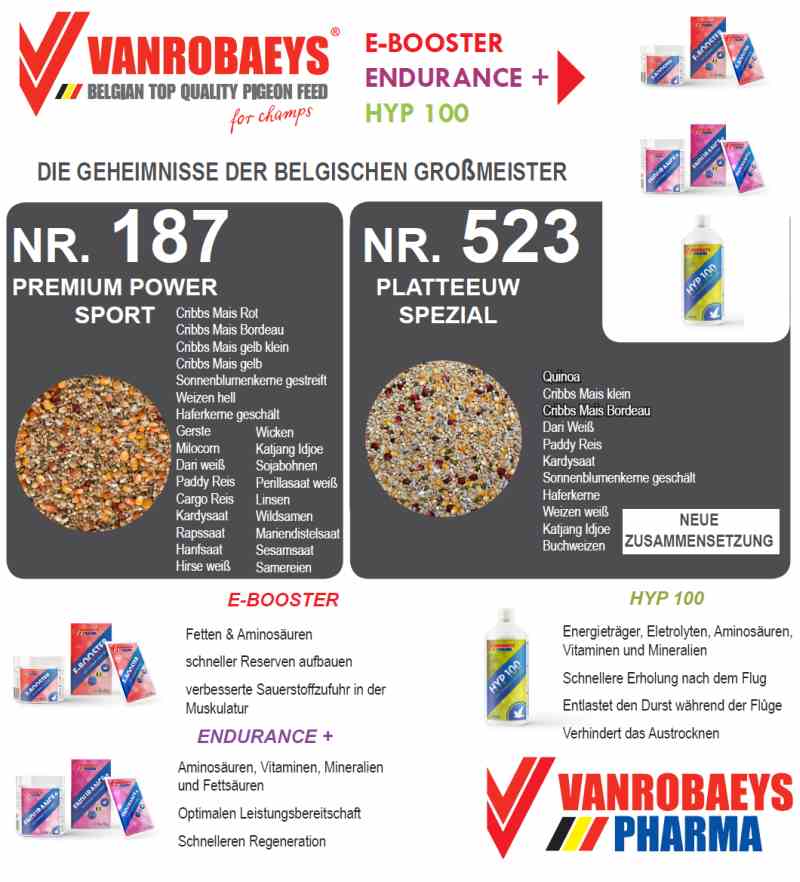EDDY JANSSENS – 1st National Champion Middle Distance Grosse Old and years of 2019
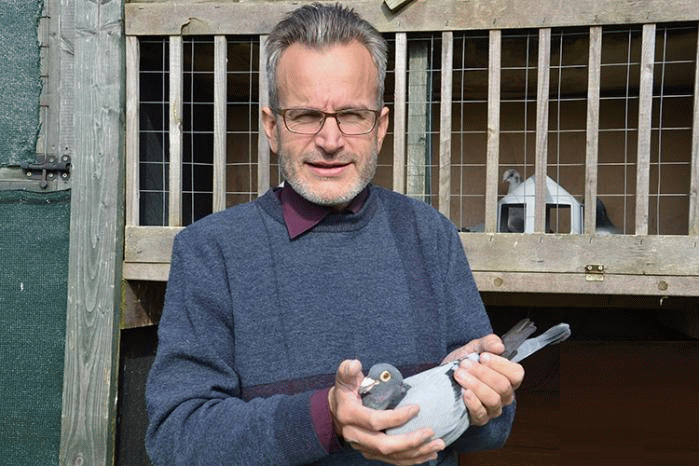
Eddy Janssens was born and grew up in Belgium Zandhoven, near the metropolis of Antwerp and he is now already, despite a well-established size in the pigeon sport at his relatively young age. dirk van Dyck was the chairman of the "Duivenbond Zandhoven" and Eddy was his "Secretary", just in the glory days of this 100 year association. But here, too, time no longer allows this work to be continued used to perform and so it happened that just the breeders of short-haul flights to merge with the neighboring association at the end of 2018 had to and so now have to go to the neighboring Zoersel to insert. Through this the necessary tasks were then redistributed and at the same time are in a competition then again more pigeons at the beginning.
Zandhoven has always been a real "pigeon's nest". Jos Soontjes from Wommelgem was not the first to remark that here too great competition is to be expected. Around here today there are so real ones Top breeders such as Danny van Dyck, Pulle, Dirk van Dyck, Zandhoven, Rik Hermans, Pulle, Miel van den Brande, Zandhoven, Marcel Wouters, Westmalle, Andre Roodhoft, Pulderbos, Guy van der Auwera, Wuustwezel-Gooreind, or else also in modern times e.g. Hans Smits, Zandhoven at home and are in direct Competitor.
Eddy Janssens did not feel that the 2019 season had ended as he had imagined. However, the reason for this was that mother Paula (88) had health problems and is now in assisted living.
As a result, Eddy did not have 100% focus on his pigeons during this period. As a result, the last month with his youngsters was not "intoxicating", although the results were still very remarkable. Now the situation with mother Paula is settled and now you can fully devote yourself to the passion of pigeon sport.
Despite the fact that an outstanding season was played here in Zandhoven with the end result of 1. National Champion Longer Middle Distance Olds and Yearlings of the KBDB, so the middle distance (each 2 named) for old pigeons and yearlings. Were used here:
18.5.19 – Vierzon – 2.288 Tauben – 31st + 113th – 25.5.19 – Bourges – 24.055 Tauben – 2nd + 119th –
7/21/19 – Issoudun - 8,248 pigeons - 21e + 362e - 8/3/19 - Bourges - 10,410 pigeons - 403e + 508e –
8/10/19 - Chateauroux – 1,231 pigeons – 28e + 47e
The base of the colony
When Eddy started with pigeons on his own, it was his father's old pigeons at first. We also had a good start with the pigeons of his good friend Dirk van Dyck from the lines of "Rambo" and "Kannibaal". At that time Dirk still had very good pigeons, especially for the short distance. Also pigeons from Jos Dillen, Zandhoven did more than just well. "Witkop Joske", (1992) flew as a youngster 8 times in the 1st tenth of the short distance to Argenton. Eddy also had good success with pigeons from Andre' Bellens. But straight varieties of "Rambo" and "Kannibaal" by Dirk van Dyck have deceitfully shaped their own breed to this day. Eddy got, among other things, a daughter of "Superke 001" and a daughter of "Kannibaal", which he called "Anna" and which have emphatically shaped the pigeon tribe to this day. From Miel van den Brande-Rik Hermans came Propere Emiel, which became the bird of the main flock. The introduction of a daughter of "Super 53", the Olympic bird and exceptional sire of the Dutch loft community, the Atema brothers from Noordbergum, turned out to be an absolute top breeding hen and, together with "Propere Emiel", formed the No. 1 parent couple Bart and Nace van Oeckel , Oud-Tunhout delivered the mother of the "Schoon Madammeke", Eddy's Olympic pigeon. Bart Gilles, Arendonk was the supplier of the "Louis" who developed into a tremendous sire. Bart dropped off a lot of youngsters in 2009 and said Eddy should be able to get a few youngsters from him. Among them sat the top hen "Rihanna". From the Combination van Panhuis came "Capriati", which became the permanent hen of "Louis" and produced many very good pigeons.
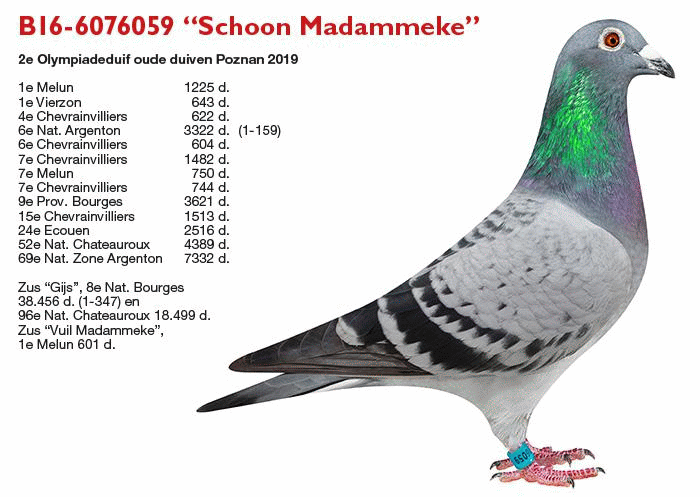
Children of "De Leeuw" and "Den AD" from Marcel Wouters, Westmalle provided very good offspring. Friend Danny van Dyck, Pulle then brought the mother of today's figureheads "Power Boy", "Power Girl" and "Power Witpen". With a great deal of excitement, Eddy formed a pigeon breed that found itself at the very top of Belgian pigeon racing!
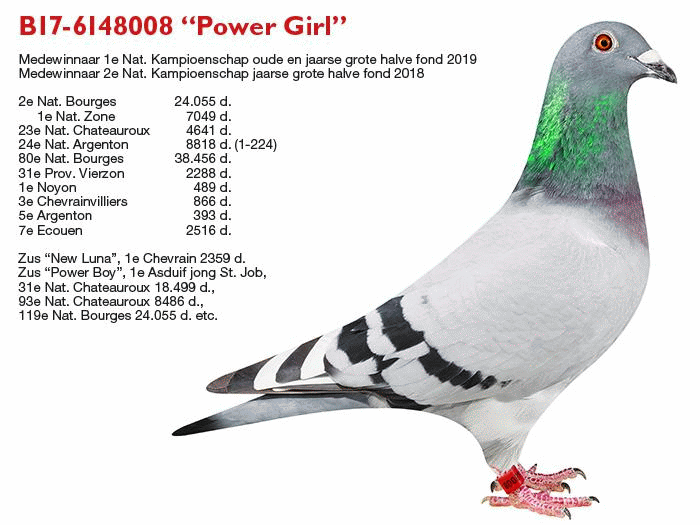
Condition is the buzzword
Eddy started in 2019 with 12 widowers, 19 hens on widowhood, 200 youngsters, 24 breeding pairs and 24 so-called "stock couplers" as foster couples. These nurse pigeons then get the first round of breeders and then bring the second round of the best widowers and racing hens big. The widowers are mated around December 6th and raise 2 youngsters each and stay together until the hen has laid a second time. These eggs go then as described to the pairs of nurses.
After the separation, the widowers and their hens get together a few times over the weekend. This is usually during the acclimatization phase or during your own training flights. The actual training always begins here, depending on the weather already after the award ceremony of the "Gouden Duif" (mid to late February). At the beginning there is always training once a day and as soon as the weather changes for the better, training takes place twice a day. The widowers are then taken to 4 to 5 stages over approx. 30 km, in order to then complete 2 x Quievrain (approx. 100 km), 2 x Noyon (approx. 220 km) and then to complete the middle-distance flights. Some of these widowers then remain on the middle-haul flights and selected ones on the national flights. After the season, a round of youngsters is bred from the best widowers.
When basketing, the hens/birds are not shown. After returning, they stay together for a few hours, depending on the course of the flight. If it was a relatively difficult flight, it is also possible that they stay together until the next morning. Eddy plays his widowhood in his own way and it is more important to him to be at the front for years than just to set a "ray of hope". Condition is the keyword and for Eddy the most important thing on his own loft. When you get form on the punch has, as a breeder you can't really do much wrong.
- The biggest secret in pigeon racing is that the pigeon sport is a secret - The nice thing about the pigeon sport is that we all know very little about it and therefore discuss it a lot be able-
Playing with the females
The hens are also mated around December 6th each year and bring up a round of youngsters. They stay with their mates until they lay again. These eggs are also placed under the nurse pairs. After that they go to the adjoining loft with a seating rack, which then also becomes their domicile during the flying season. They will then remain here until the national flights are due or they are also played on Nest.
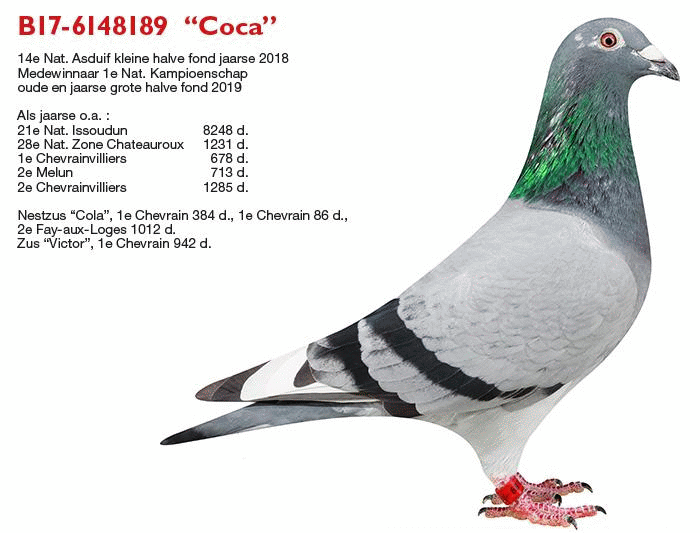
Eddy: “The mating of the females on widowhood is actually not a problem. The females' perch actually has 2 doors behind which I can actually put the females, but I haven't really had to do this until now. Mating the females was actually my biggest concern, but luckily that wasn't the case. A parr is sitting in the hallway, which depending on the situation has eggs or young. These now ensure that the hens do not stay long on the ground be able. It is also important that the hens after the separation once a week with their partners come together so they don’t forget their partner.”
In 4 to 5 The pigeons are trained over approx. 30 km, followed by 2 x quievrain and 2 times to fly Noyon and then some Complete medium-haul flights. Most of the pigeons are basketed on the national flights. The partners are not shown when basketing. After returning but for a few hours already. Last season was for the first time on July 15th paired and the second time on August 1st. With this system my chances are better for pigeons.
Eddy is the one Opinion that pigeons fly better than birds, but they also get more chances because they have to go with them every week.
Easy feeding
Eddy follows the feeding system of the Give. They are babaeys. All pigeons are fed together in feed troughs. The pigeons that stay at home at the weekend are fed as if they were on a race would have participated.
On Saturday, when most pigeons come home, "Relax No. 183" (light mixture) is fed. In the drinking water is "Belgasol", "Herbosol" and Elctreolyte. The evening after the separation there is 50% "Dynamic No. 184" (fat) + 50% "Premium Power Breeding No. 82" (protein).
On Sunday and Monday is then fed 100% "Relax No. 183". Tuesday and Wednesday will be 50% "Dynamic No. 184" + 50% "Relax No. 183" lined. Then on Thursday 100% "Dynamik No. 184", which then on "Top Energie Nr. 35" is added on Thursday evening. This for the pigeons on the middle and long distance races take part.
pigeons at participating in the short-haul flights will be fed 100% “Relax No. 183” from Tuesday.
As an encore, all pigeons receive “BonchoStar” (a product made from liquorice extract + herbs for the respiratory tract) on Monday through the feed. “Endurance +” (a product made from various minerals, trace elements, electrolytes and vitamins) is also given on Tuesday and “E-Boost” (as an energy source). On the day of basketing, "Hyp100" (energy drink with amino acids, vtamines and electrolytes) is also added to the drinking water. On Thursday there is also always a little hemp seed, sunflower seeds and nutripower after the actual feeding as a "little attention".
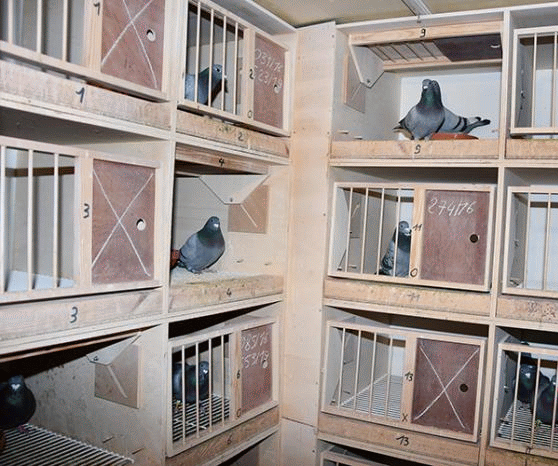
Adeno every year
Every 2 to 3 weeks, Eddy and his pigeons go to the control Vet Raf Herbots and he strictly follows his instructions. Veterinarian Stijn Gijsbrechts takes care of all necessary vaccinations. The products from F. Marien, the condition syrup (once a month), condition powder (on the day after the race) and the red mineral (on the day of return) are used regularly.
Before the Travel season, all pigeons are released from Trichomonads and old, as well young pigeons are with dealt with the "gel druppels". The youngsters, on the other hand, are treated twice against Tricho. It will also be 2 x for the upper airways treated. This product is then manufactured by the veterinarian depending on the situation. Occasionally, eye drops prescribed by the veterinarian used.
The youngsters are vaccinated against Paramyxo 4 weeks after weaning and the second time a month later. A 10-day cure is planned for paratyphoid and then vaccinated again. Eddy: “Unfortunately my pigeons get problems with Adeno every year. I always have to do this with a product from RAF Herbots contain. In addition, I then add an electrolyte to the water and feed the pigeons for a few days with a light mixture ("Relax No. 183"). Usually everything is over after about a week. The only bad thing is that you have lost another week as a result to be able to train the youngsters! ”
Gratings and conveyor belts
The widowers have 3 lofts, each with 12 cells, but usually only 2-3 are occupied. The hens 1 loft with 24 cells, the youngsters 6 departments with 40 seats each and additionally 10 triangular seats on the side walls and the breeders 2 lofts with 12 cells each. They are all non-insulated lofts fitted with wooden grates and manure belts. Aviaries are built in front of the youngsters' lofts Windbreak nets are sheathed and in front of each There is a corridor 1 m wide in each beat. The lofts are "generally cleaned" once a year and disinfected, but the droppings under the slats of the youngsters are regularly removed.
Eddy: "A pigeon fancier once told me that the pigeons, in order to maintain their condition in the loft would have to remain! I believed him and my pigeons only came in the Aviary when the temperature was above 25 degrees, so that you could swim! This is absolute nonsense, because pigeons have to fly to improve their condition get , or improve. The pigeons have to decide for themselves know what is good for them!”
improve breeding
The breeders are mated around December 6th. The pairs that produce good youngsters stay together and are not paired. We also try not to breed in families. Good to good is the premise here.
Eddy: "If I have found a good pair, i.e. bird A x hen B, I try to form a new pair with e.g. a brother of bird A with a sister of hen B, to then see if there is more in this family. The breeders are selected based on the results of the youngsters. I prefer pigeons to be able to fly the top than pigeons that have many prizes but do not find themselves in the top. Breeding pigeons are given 2 years to produce useful youngsters. If there is something "special" here, you have another year to decide demonstrate. I also get something new every year, but then only out absolute "toppers". Of course there will be 4 every year brought up 5 pigeons from breeders of which I have spoken so far have very good pigeons.”
This year I was able to rejuvenate my breeding stock with my own pigeons. So then "Power Boy", "Power Girl" and "Schoon Madammeke" came into the breeding stock, although there were very high offers for them, but I don't want to sell my line or the "flagships" of my loft and I won't sell them for the next few years have fun with them! For this company I exposed the current breeding pigeons in advance and also briefly pre-paired them.
Find the toppers
The norm in the selection is ongoing, multiple head prices. Of the approximately 200 youngsters, only about 30 have the chance to reach the individual adult lofts. Head prices are prices among the first 100 for old and yearlings with the corresponding number of pigeons. With the youngsters, Eddy is a bit more forgiving here. The outward presentation of the pigeons differs from the successes, but it is usually the case that pigeons that are at the top of the big races also fit well in the hand assessment. Most breeders compare but also with the Assess the pigeons that fly best with you.
Of course, there can always be differences, because a different pigeon family flies on each loft. The character is also decisive here, because the murderous feeling, i.e. the will to return home, is of great importance and has nothing to do with the actual assessment do, whether big or small, etc.
Eddie: I am fortunately now a professional pigeon fancier and I want some more realize. Winning the "Golden Duif" is the top priority! But a national victory is also a goal to strive for. I have so far achieved all national rankings in the top 10, but unfortunately so far the "Golden Duif" not yet. It's not efficient larger releases on smaller ones To form distances, because here is mostly the situation and then the wind decisive. I am also against limiting the number of pigeons. Both national titles only count for the aforementioned and so does he "small" breeders have no disadvantage compared to the "mega lofts".
That is nothing more to add!
Translation from “De Duif” by Klaus Sax
Advertising:
